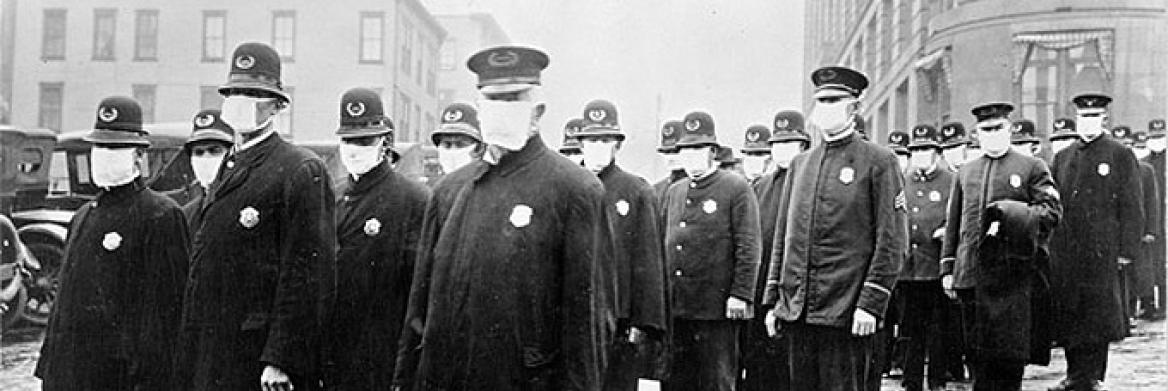
In December 1918, Seattle police officers patrolled the streets to ensure public safety. Wearing masks was mandatory for police in Seattle during the Spanish Flu pandemic. Credit: National Archives at College Park, MD.
This year, 2018, marks the 100th anniversary of the flu pandemic-one of the deadliest disease outbreaks in recorded world history. About one-third of the world's population, or 500 million people, contracted the virus, and an estimated 50 million people died from it.
We asked Associate Professor Stephanie Yanow about the impact the pandemic made on today's public health knowledge and practices.
What conditions existed that contributed to the 1918 influenza reaching pandemic level?
The pandemic emerged during World War I. Living and fighting in close quarters and by their movements throughout Europe, soldiers easily spread the virus. The end of the war was the perfect opportunity for influenza to spread around the globe as soldiers returned home from foreign countries, carrying the virus with them. At that point in world history, people were not exposed to as many foreign pathogens to build natural immunity, so they were more susceptible to influenza.
How has our response to pandemic threats improved since 1918?
Canada's first federal department of health was created in 1919. It came from recognizing the country's response to influenza was not well coordinated and that there was a need for pandemic preparedness and better communication. Today's Public Health Agency of Canada directs Canada's response to pandemics.
Globally, the World Health Organization's Alert and Response Operations gathers intelligence on outbreaks and suspected outbreaks to alert health ministries worldwide on epidemic threats to public health. With a systematic approach and modern technology, our capacity to respond to potential public health crises has improved.
Are there conditions that exist today that make another pandemic possible?
Globalization is a complex, double-edged sword. While our connections allow us to better monitor and track outbreaks of communicable diseases around the world, globalization has also increased the frequency of our interactions with others, and the potential for transmission of those diseases.
Our patterns of relatively quick movement around the globe combined with an increase in anti-microbial resistance, and the fact there are very few effective anti-viral treatments are just a few factors that could contribute to a modern-day pandemic.
What tools do we currently have to fight a pandemic?
In the past 100 years, we've developed education campaigns, vaccines and drugs that protect and promote better public health, in general. Organized, systematic surveillance and communication of disease outbreaks are also advantages we have today. Overall, our capacity to prevent threats and to respond to them effectively has improved.
Our more frequent and broad travels give us some protection, too. When we visit new environments, we're exposed to new pathogens that can increase our immunity. Today, there are few remote populations that would be decimated by an influenza virus, as happened in 1918.
Our use of genomics in the past two decades is significant. By examining the structure and sequence of the genome (the DNA and RNA), an emerging pathogen can be identified in a matter of days. New pathogens can be compared to familiar ones to see how they are similar, how the new one might behave and what tools we need to fight it.
This information allows us to develop diagnostic tests to screen for who has contracted a disease (and who has something else) and to track its movement and evolution. Importantly, genomics provides the information to develop vaccines.
Vaccines, genomics, technology…so many advancements, but people still get sick with diseases that have no cure. What are some diseases that challenge researchers, and why?
Viruses tend to mutate quickly, so there are very few effective anti-virals to treat diseases such as dengue fever and HIV. Treatments and supportive care have improved, but there are no cures.
Tuberculosis (TB) is an example of a bacterial infection that can be treated with antibiotics; however, increasing resistance to antibiotics means multiple standard TB treatments have become ineffective.
Tropical diseases are challenging, including malaria-my area of research. Thanks to intensive control efforts, malaria has steadily declined in recent decades. However, this success is threatened by the emergence of parasites that are resistant to our front-line drug, artemisinin. Drug resistance evolved in Southeast Asia, and we are concerned these parasites will spread to sub-Saharan Africa where there is the greatest burden of disease. If that happens, we risk losing our most effective drug to treat malaria and the death rate will increase again.
Tropical diseases don't pose a threat to us in Canada, so why should we be concerned about research in those areas?
Having sustained support and research for a lot of different pathogens has great scientific and public health value in a global context. We don't know if the next pandemic that threatens us will be caused by something that looks like malaria. So not only does my research help people in other countries, but it could provide tools, knowledge and capacity to respond to something that affects Canadians in the future.
Our health is connected, and our diseases are connected-we need to support each other to strengthen those connections.
Associate Professor Stephanie Yanow will deliver the next This is Public Health™lecture entitled Worldwide killers: Public Health Responds, diving deeper into the 1918 pandemic and the role public health plays in responding to emerging threats.